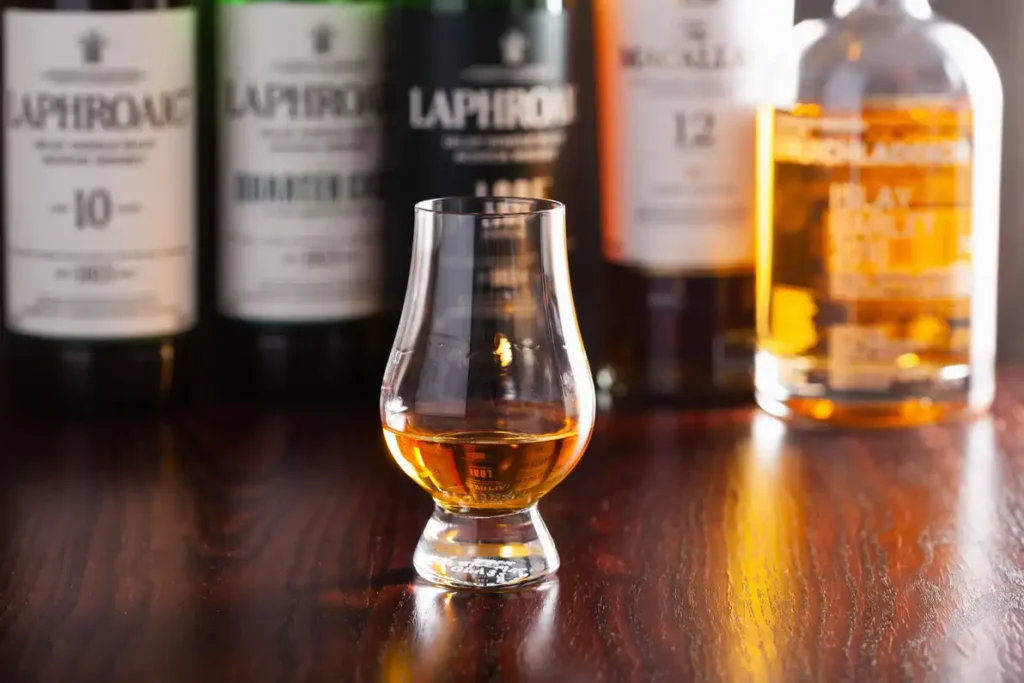When people go out for a whiskey tasting, they want to analyze and better understand what they’re tasting. It doesn’t matter if you're a beginner or if you have been tasting whiskey for years; this ultimate whiskey-tasting guide can walk you through the steps of whiskey drinking from an advanced perspective, allowing you to gain a better understanding of the flavors in your glass.
There are various types of whiskey glasses out there when visiting a whiskey distillery, with some of the most common types of glasses being rocks glass, tulips glass, highball glass, neat glass, and Glencairn glass.
The most popular and common type of glass for whiskey tasting is the Glencairn glass used at a whiskey distillery. The Glencairn glass has a shorter rim, and its shape allows for the perfect swirling technique while the rim traps the aroma. Whiskey distilleries will typically make it their go-to whiskey-tasting glass.

When whiskey tasting, there are many types of whiskies out there, so it’s essential to keep notes of the whiskey samples when out for a tasting. While they may assume they can keep tabs on the endless amount of whiskies they’re tasting, it’s nearly impossible to remember the names of every type of whiskey tasted. Bring a notebook or journal to the whiskey distillery, or take notes on a tablet or phone.
TIP: Complement your whisky tasting journey with The Scotch Whisky Tasting Toolkit, a valuable resource that offers expert tips and templates to elevate your note-taking and further refine your tasting skills.
Before sampling whiskey, it’s essential to remember its color. The color of the whiskey can tell a lot about its cask quality used during the maturing stage and the kind of spirit casks they were held in before it was full of whiskey. Whiskey with a golden color may have matured in a bourbon cask, whereas whiskey with a red color may have matured in a red wine cask.
Whiskey with a lighter color may indicate it is young and was matured in the first fill. Color can essentially have no meaning when it involves whiskey, too! Sometimes, a whiskey distillery can add caramel coloring to give the appearance of an aged spirit.
In summary, the color of whiskey is only essential if it’s natural, so if visitors at a distillery are mindlessly tasting whiskey, they would make an educated guess based on its aroma, natural coloring, and taste.
When whiskey tasting, use a swirling technique to coat the side of the whiskey glass and bring it closer to take a whiff. While opening their mouth slightly, the taster should whiff the whiskey. The aromas the taster smells can tell a great deal about what they’re about to experience when taking their first taste of whiskey.
To reduce the burn, take a small sip of the whiskey. The taster should swirl the whiskey around in their mouth similarly as they would swish mouthwash after brushing their teeth. What kind of consistency does the whiskey have?
What flavors burst out when taking that first sip? When whiskey tasting, keep notes on how long the flavor lingers, referred to as the finish. When visiting a distillery, and they’re used to beers and wines, it can take some time to become used to whiskey flavors with higher alcohol content.
As the taster’s palette improves, they can pinpoint more details about the flavors and other notes about the whiskey.
Despite what some whiskey experts say, there’s nothing wrong with experimenting with water when whiskey tasting. Sometimes, adding a splash of water can improve the whiskey, reducing the burn and opening up the palette to efficiently taste the whiskey. As a first-time whiskey taster, order the whiskey neat before adding water to find the best flavor.
When adding water to whiskey, ensure that it’s free from chlorine and other chemicals, or it could create a negative impact on the whiskey. To avoid dilution, use a dropper to add water. It’s essential to remember more water can always be added, but too much can over-dilute the whiskey, taking away from its flavor.
On certain critical occasions, tasters should avoid eating food during a whiskey tasting. Eating food before a whiskey tasting can interfere with adequately analyzing the whiskey. When going out for a casual tasting, light snacks may be consumed.
So, excellent snacks to consider are cheeses, deli meats, or fresh fruits. Since every whiskey is unique, finding the best food pairings is crucial to an exceptional tasting experience.
Not everyone who goes out for whiskey tasting enjoys it, so don’t feel pressured. In a whiskey distillery setting, many visitors feel pressured to try a new drink, but this doesn’t have to be the case. When whiskey tasting, keep trying until there’s one that perfectly suits the palette.
Whiskey tasting is all about enjoying the experience and experimenting with new flavors. Everyone has unique taste buds, and whiskies are no exception when it comes to finding the most suitable flavor.
Spirit Radar collaborates with the best professionals who test and share their tasting experiences with people worldwide. By including different prices and unique collections, they can provide excellent deals for buying whiskey at the best price. Check out some of their whiskey brands from the link below to discover some of the best-tasting whiskey out there!
As a beginner, you should taste the whiskey once, add a few drops of water, and then taste it again. Adding warm water will allow the whiskey pores to open, reducing the alcohol content and raising the flavor.
If you’re tasting whiskey without diluting it, high alcohol content should remain towards the end.
The elements of whiskey tasting are visual analysis, nose, palate, finish, and water.
At a whiskey tasting, your tastings will be small, around half an ounce.


